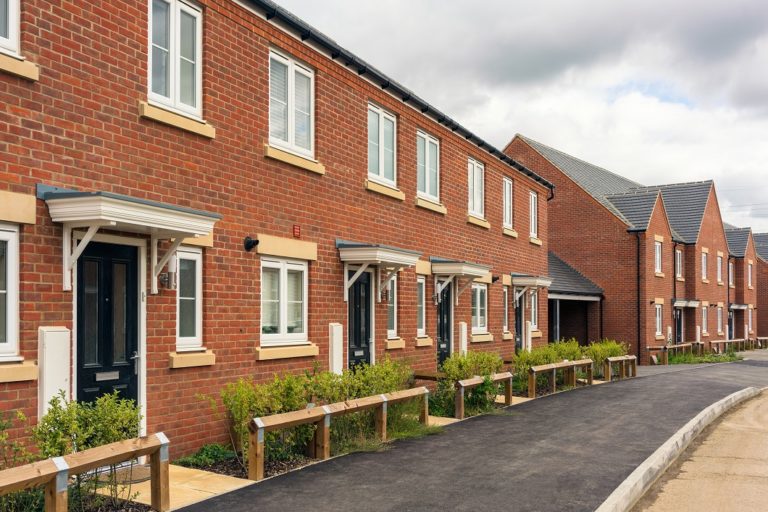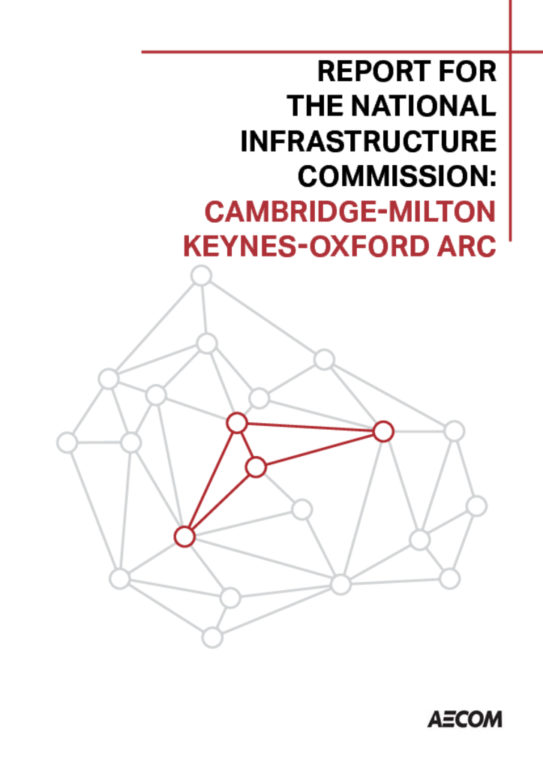Place
Infrastructure can improve the economic prospects of local areas and help to enhance the distinct identities of the places where we live, work, and enjoy life.
Updated:

Summary
The Commission adopts a place based approach to its thinking, reflecting the results of social research which showed 8 in 10 people believe good infrastructure is necessary to support a good quality of life.
The Commission adopts a place-based approach to its thinking, reflecting the results of social research which showed 8 in 10 people believe good infrastructure is necessary to support a good quality of life.
Infrastructure helps form the identity of places as well as creating efficient links between them. Better transport infrastructure can alleviate bottlenecks to growth in congested areas and improve connectivity, while infrastructure improvements also have the potential, alongside other policies such as skills training, to increase growth in lower productivity areas and help efforts to level up the economy.
Our towns study, for example, found that transport and digital infrastructure in particularly have an important role in supporting economic growth & better quality of life in towns and cities; while our 2022 Getting cities moving report identified the need to get more people making more trips into and around city centres to boost growth in English cities outside of London, without adding to congestion or undermining existing net zero objectives.
These reports informed many of the recommendations in the Second National Infrastructure Assessment on supporting growth in all regions of the country. These include:
- cities adopting flexible strategic transport plans that can adapt to a range of future transport demand scenarios – backed up by £22 billion in long term funding for major transport projects between 2028 and 2045 – to get more people making more trips into and around city centres
- to support this, government should make this long term funding for major projects conditional on the introduction of demand management schemes, to be designed to work best in a city’s local context
- devolving power to local authorities responsible for strategic transport, to allow them to plan for the long term
- ensuring gigabit capable connectivity is available nationwide by 2030, along with accelerating the deployment of 5G technology.
While the Commission’s remit does not include housing provision, we have advised government on how utility services can better support proposed housing developments and help enable the scale of house building needed to accommodate a growing population.
Data on place
A range of data sets relating to the theme of place is available to review on our Data pages. This includes data sets used in Commission reports, as well as historic data sets. Each can be reviewed online or downloaded.
Review dataNext Section: Key issues
Here you will find a summary of the Commission’s position on key issues emerging from our work in specific places, and on wider issues related to place.
Key issues
Here you will find a summary of the Commission’s position on key issues emerging from our work in specific places, and on wider issues related to place.
Improving transport investment and planning in cities
England’s largest cities are congested and their public transport networks underperform relative to comparable European cities. It is important to ensure that the largest regional cities to ensure they have the public transport capacity – seats and standing space on bus, trams and rail – they are likely to need in the future to support growth and quality of life.
In the Second National Infrastructure Assessment, the Commission recommended that government commit long term funding of £22 billion for major transport projects in cities from 2028 to 2045. The initial focus for this funding should be on those cities that are likely to have the greatest need for increased capacity, but some of this funding should also be made available to other cities where there is likely to be a need for increased capacity or connectivity.
The Assessment argues that mass transit alone is unlikely to be sufficient to encourage greater use of public transport however. To encourage modal shift and enable an increase in trips in congested cities, the Commission has recommended that government should make this long term funding for major projects conditional on the introduction of demand management schemes, to be designed to work best in a city’s local context. The revenue raised should then be retained by the local area for investment in public transport and active travel.
While central government will be the primary source of capital funding for major transport projects in cities, cities should be expected to contribute towards the costs. Government should work with cities to investigate and facilitate financing mechanisms and funding sources that could include a combination of business rates retention, third party contributions, forms of land value capture, and new income streams, to support the delivery of local public transport infrastructure.
Using infrastructure to support growth and regeneration in towns
The Commission’s 2021 study on Infrastructure, Towns and Regeneration considered infrastructure can best support economic regeneration and improve the quality of life for people living in towns across England.
The study found that the existing multiple funding streams available to towns tend to be short term, ringfenced and often require rounds of competitive bidding. In response, the Commission recommended central government should simplify these funding streams and provide those county councils and unitary authorities that are responsible for strategic transport planning with more flexible, devolved five year budgets for local transport. This will be important in ensuring the government can achieve its levelling up goals.
Alongside improvements in funding, the Commission’s study encouraged government to ensure all towns have sufficient access to key infrastructure networks, such through addressing gaps in gigabit broadband coverage, including by supporting experimentation in towns, such as innovation pilots related to 5G use cases and on demand bus services. This report also helped inform the work leading to the recommendations on growth across all regions in the Second National Infrastructure Assessment.
Full fibre rollout
Digital connectivity has become an essential service, vital to the country’s economic growth and to people’s quality of life. Businesses, charities and public sector organisations are dependent on digital technology to operate effectively. Individuals rely on digital services to perform day-to-day tasks, access public services and shop online. Future innovations will increasingly rely on digital connectivity, from connected and autonomous vehicles (CAVs) to new applications of virtual reality.
As well as offering benefits for home broadband users, enhanced digital connectivity will also facilitate the development of 5G mobile communications and smart infrastructure, enabling more agile and more efficient management and maintenance.
The Second National Infrastructure Assessment recognised that coverage of gigabit capable connectivity has improved in recent years. But to ensure the UK meets the target of nationwide coverage by 2030, it recommends that policy and regulation must continue to support private investment in networks and competition. Government should also finish delivering the £5 billion subsidy programme to provide coverage in the hardest to reach areas.
Supporting housing growth
With a growing population, there is increasing pressure on local government to deliver new homes and communities. The National Infrastructure Assessment highlighted how problems with the deployment of economic infrastructure essential to any home – electricity, water, broadband – are creating barriers to improving the efficient delivery of new housing.
Further research published in 2020 – drawing upon discussions with developers, planners and infrastructure providers – highlights concerns with the relevant legal, regulatory and governance frameworks and argues for greater transparency and coordination along with better allocation of costs and risk to enable more effective delivery of the infrastructure needed for new communities.
Better by design
The Commission’s Design Group was established in May 2019 following a recommendation in the National Infrastructure Assessment, which highlighted how projects can benefit from good design. Chaired by Professor Sadie Morgan, it brings together leaders from engineering, architecture, transport and landscape, to champion design excellence in infrastructure.
In February 2020 the group published the Design Principles for National Infrastructure. This set out four principles – climate, people, places and value – that should guide the planning and delivery of major projects. The government has subsequently committed to the principle of embedding good design in all infrastructure projects in its National infrastructure Strategy.
The ‘places’ principle stresses the role of infrastructure in giving places a strong sense of identity. The principle envisages that well planned and well-designed infrastructure will make a positive contribution to local landscapes within and beyond the project boundary. It calls on projects to be inspiring in form and detail, respecting and enhancing local culture and character without being bound by the past.
Cambridge - Milton Keynes - Oxford Growth Arc
The arc running between Oxford, Milton Keynes and Cambridge is one of the fastest growing, productive and successful areas of the country, playing a crucial part in its economic prosperity. Estimates produced four years ago suggested that by keeping house building at the 2016 level of 14,000 a year the area might support around 335,000 new jobs to 2050, increasing economic output by around £85bn per annum; doubling the housebuilding rate increases that to around 1.1m new jobs and £163bn per annum.
Affordable housing, integrated transport and other infrastructure are essential to maximising its potential as a global knowledge-intensive cluster, protecting its environment and securing new homes and jobs. Our 2017 study recommended a new deal between government, local areas, and communities capable of supporting up to 1 million new homes by 2050. A subsequent government spatial plan announced in February 2021 included plans to adopt an arc-wide approach to planning, in line with the Commission’s recommendations.
Headline recommendations
Government should commit to long term funding of £22 billion for major transport projects in cities
Government should commit long term funding of £22 billion for major transport projects in cities from 2028 to 2045. The initial focus for this funding should be on those cities that are likely to have the greatest need for increased capacity, justifying investment in rail or tram type projects – the Commission’s analysis indicates that these cities are Birmingham, Bristol, Leeds and Manchester. Some of this funding should also be made available to other cities where there is likely to be a need for increased capacity or connectivity. To reflect the uncertainty over future travel demand and cost, the total investment package should be reappraised before final decisions are made on which projects to take forward
Encourage modal shift and enable an increase in trips in congested cities
To encourage modal shift and enable an increase in trips in congested cities, government should make the long term funding for major projects outlined in recommendation 17 conditional on recipient cities committing to introduce a demand management scheme, in a way that is designed to work best in the local context. The exact form and sequencing of the demand management scheme should be a decision for the individual city, and the revenue raised should be retained by the local area for investment in public transport and active travel.
Cities benefitting from major transport projects should make a significant contribution to capital costs
The cities that directly benefit from the major transport projects outlined in recommendation 17 should make a significant contribution to the capital costs. Government should expect a local contribution of at least 15 to 25 per cent towards the total cost of the investment – although there are scenarios where a higher contribution may be expected, particularly for less expensive investments. Government and the UK Infrastructure Bank should work with cities to investigate and facilitate financing mechanisms and funding sources that could include a combination of business rates retention, third party contributions, forms of land value capture, and new income streams, to support the delivery of local public transport infrastructure.
Government should move faster in devolving powers and funding for local transport to local authorities
Government needs to move faster in devolving powers and funding for local transport to local authorities. By the next Spending Review, government should have agreed single multiyear financial settlements for existing mayoral combined authorities to invest in local priorities, and then continue to roll these out to new mayoral combined authorities. All county councils and unitary authorities that remain responsible for strategic transport planning should be provided with devolved five year transport budgets by the end of 2025, sufficient to cover maintenance, renewals and small to medium enhancements.
Government should ensure that £8 billion a year is available for devolved transport budgets for local authorities outside London, consisting of a combination of central government grants and locally raised funds.
Government should replace short term funding deals for TfL with five year funding settlements
21. Government should replace short term funding deals for Transport for London with five year funding settlements, sufficient to enable both the renewal and enhancement of London transport. Government should work with the Mayor of London to establish the priorities for public transport enhancements over the next ten-20 years and reach agreement on the appropriate combination of grant support, retained business rates and local mechanisms that can be used to finance and fund them
Maintain the existing road network by investing adequately in maintenance and renewal
Government’s first priority for roads should be to maintain the existing network by investing adequately in maintenance and renewal, including to ensure proportionate resilience to climate change impacts. Government should enhance the road network on a strategic basis, with improvements targeted at underperforming sections of the network, aligning schemes with complementary policies for economic growth and giving initial priority to interventions in regions with underperforming productivity.
By the end of 2026 and ahead of commencing work on Road Investment Strategy 4 (2030 to 2035), government should use the improvement options outlined in the Commission’s analysis, alongside projects identified in partnership with sub national transport bodies, mayoral combined authorities and pan regional partnerships that unlock regional economic opportunities, to develop a pipeline of future interurban road projects over a thirty year horizon.
Prioritise maintenance and renewal of the existing rail network
Government should prioritise maintenance and renewal of the existing rail network, ensuring proportionate resilience to climate change impacts. Government should develop a new comprehensive and long term plan for rail enhancements to address the capacity and connectivity challenges in the North and Midlands, alongside completion of East West Rail and a portfolio of targeted network enhancements across the country.
Local authorities should include urban freight within their infrastructure strategies
To help manage peak time congestion on the urban transport network, local authorities should include a plan for urban freight within the infrastructure strategies they are developing. These plans should review local regulations to incentivise low congestion operations, consider the case for investments in infrastructure such as consolidation centres, and identify the land and regulatory requirements of new and innovative low congestion initiatives.
New planning practice guidance on freight for strategic policy making authorities
Government should produce new planning practice guidance on freight for strategic policy making authorities. The guidance should better support these authorities in planning for efficient freight networks to service homes and businesses as part of their plan making processes. This new planning practice guidance, which should be prepared by the end of 2020, should give further detail on appropriate considerations when planning for freight, such as the need to:
- provide and protect sufficient land/floorspace for storage and distribution activities on the basis of population and economic need, with particular consideration for the floorspace requirements for last mile distribution and consolidation centres;
- support the clustering of related activities within a supply chain, minimising the distance that goods must be moved and maximising the potential for efficient operations;
- maximise the potential for freight trips to be made at off peak times; and
- accommodate deliveries and servicing activity at the point of delivery.
Transport should be designed to unlock major housing growth
- 1a: Government should progress work on East West Rail, the Expressway and new settlements through a single co-ordinated delivery programme, with cross-government ministerial commitment and oversight. The aim of this programme should be to unlock opportunities for transformational housing growth through the creation of well-connected new communities. As part of this programme Government should commit:
- £1bn to deliver the infrastructure necessary for a high quality and resilient rail commuter service between Bicester and Bedford, accelerating delivery of this section of East West Rail to a target date of 2023;
- to accelerate work on the development of the new East West Rail line between Bedford and Cambridge, and commit to open the line by 2030; and
- to deliver the ‘missing link’ of the Oxford-Cambridge Expressway, accelerating development work to deliver a clearly-defined and agreed route by 2025, enabling construction to begin as part of the next Road Investment Strategy (RIS 2) and be complete by 2030.
- Key milestones and decision points in the development of East West Rail and the Expressway should be subject to “in principle” agreement to the development of significantly more ambitious proposals for housing growth in the arc, including major new settlements and urban extensions, and subsequently, progress in identifying, evaluating and designating sites. “In principle” agreement should be provided within 12 months. The schemes should be futureproofed to ensure the potential for expansion and improvement is not permanently and prematurely closed.
- 1b: Government should seek to introduce fast, direct services to London to enable growth in the arc between Bicester and Bletchley and improve connectivity between London and Aylesbury. Any such improvements should be contingent on local authorities’ commitment to major development between Bicester and Bletchley and around existing settlements.
- 1c: Government should work with the private sector and the relevant local authorities to agree funding packages and progress schemes to support housing and employment growth now. These should include:
- essential works required to enable passenger services between Oxford and Cowley no later than 2019
- the acceleration of East West Rail phase 3 works around south Cambridge to enable the deliver of a Cambridge South station in 2022 as part of Control Period 6.
- Substantial private sector and local contributions, reflecting the benefits that these parties gain, will be required to enable the delivery of these schemes.
Government should work with local authorities
- 2a: Government and local authorities should work together, through a robust and transparent process, to designate locations for new and expanded settlements by 2020. This should involve:
- commissioning formal studies to identify and assess options for new settlements required, and potential locations for these settlements
- consultation with communities, statutory agencies, infrastructure providers, wider stakeholders and public examination of proposed sites
- formal designation of sites and the publication of such assessments as legally required.
- The Commission is optimistic that Government and local authorities will reach agreement on the scale and location of new settlements in the national interest. However, if agreement cannot ultimately be reached, the Secretary of State should designate these new settlements.
- 2b: Government should:
- work with local authorities to establish appropriate delivery vehicles for new and expanded settlements across the arc, considering the role that can be played by locally accountable Development Corporations, Mayoral Development Corporations, the Homes and Communities Agency and Urban Development Corporations
- establish New Town Development Corporations to deliver larger new and expanded settlements.
- In so doing, it should:
- work with local authorities to define and agree the objectives, membership and reporting arrangements for new development corporations
- provide a clear remit to support the economic success of large new settlements as centres of employment, and assist the development corporation by using wider policy levers to support local economic growth
- explore the full range of options for funding development corporations’ programme of land acquisition, including providing public funding with a view to unlocking substantial private investment, and balancing considerations of short term affordability and long term value for money.
Effective placemaking should deliver well-connected, sensitively designed new places
- Government should work with local authorities to put in place an independent design panel for East West Rail, the Expressway and new and expanded settlements across the arc by April 2018. This panel should work in concert with existing infrastructure design panels and new development corporations to specify, scrutinise and challenge settlement designs, plans and delivery, with a view to:
- making most efficient use of new and existing infrastructure (including transport and utilities)
- supporting positive social outcomes (including better mental and physical health)
- achieving net gains in biodiversity and natural capital across the arc
- improving quality of life for existing and future residents
- Government should establish arrangements for the long-term stewardship of valued community assets in each new or expanded settlement, placing responsibility and resources in the hands of the community – learning from both the Parks Trust in Milton Keynes and the Letchworth Garden City Heritage Foundation
- It should ensure that strategic infrastructure, including new elements of East West Rail and the Oxford-Cambridge Expressway, are planned and developed to achieve net gains in biodiversity and natural capital across the arc.
Latest Updates

Milton Keynes first-last mile strategy
Part of the evidence base which informed the Partnering for Prosperity report.

Oxford(shire) first-last mile strategy
Part of the evidence base for the Partnering for Prosperity report.

Greater Cambridge first-last mile strategy
Part of the evidence base for the Partnering for Prosperity report.

Growth corridor first-last mile strategy analysis
Analysis by SDG which formed part of the evidence base for the Partnering for Prosperity report.

Adonis: New infrastructure can bring first new towns for half a century and billions to national economy
A ground-breaking new deal between Whitehall and local leaders in one of the most economically-important parts of the country could add hundreds of billions of pounds to the national economy each year and lead to the first new towns in the UK for half a century, Lord Adonis said today. The chairman of the National...

Offering a bold vision for the future of the Arc
Knowledge corridor. Silicon arc. Brain belt. The National Infrastructure Commission has hit the headlines with its bold vision of how Britain’s economic prosperity over the next quarter of a century could be propelled by the new technologies which are booming across the Oxford to Cambridge corridor. The Commission’s report makes compelling reading for everyone who...

Securing a truly exceptional economic contribution
I welcome the National Infrastructure Commission’s report. East-West Rail and the Cambridge-Oxford expressway can transform the economic potential of the Cambridge-Oxford corridor bringing forward one million new homes by 2050. As the report makes clear, the amount the corridor generates for the national economy could increase from £90 billion per year to £250 billion. This...
The Cambridge-Milton Keynes-Oxford Arc: Responses to the Commission’s report
Organisations respond to the Commission’s report into the Cambridge-Milton Keynes-Oxford Arc: Councillor James Jamieson, Leader of Central Bedfordshire Council “We have already delivered spectacular levels of economic growth in Central Bedfordshire. We are committed to realising the economic potential of our area and sustainable growth. We agree with the Commission’s views that development should not...

Making the most of infrastructure for the Midlands
The West Midlands is on the cusp of a once-in-a-lifetime opportunity to transform our connectivity and infrastructure. Work starts next year on HS2, slashing the time it will take to travel from London to the region to less than an hour. That brings enormous economic opportunities – but also the challenge of making the most...

The need to tackle the three Cs
The Victorians led the world in infrastructure with the creation of railways, paved roads and trams. The engineers and planners of the post-war era built motorways, airports and millions of new homes. And in recent years we’ve seen such successes as Manchester’s tram network, Canary Wharf, the transformation of Birmingham New Street and the infrastructure supporting...

Adonis: tackle the three Cs and deliver world-class infrastructure
The UK faces gridlock on the roads, railways and in the skies, slower mobile and broadband connections and ever-worsening air quality unless the Government tackles the ‘three Cs’ – Congestion, Capacity and Carbon – Lord Adonis warned today. The chairman of the National Infrastructure Commission argued that the current state of the country’s infrastructure could...

Supporting cyclists in the Growth Corridor
Oxford, Cambridge and Milton Keynes are some of Britain’s fastest-growing, most productive places – and a key focus for the Commission. They could be Britain’s Silicon Valley. But they are, quite literally, running out of road. Unless we can find an answer to these cities’ often severe traffic congestion, their and our growth plans are...


